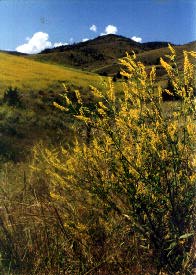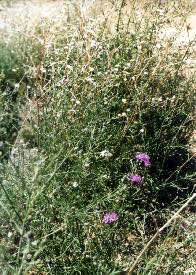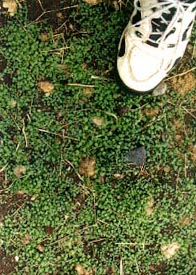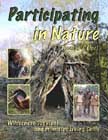What is a Weed? What is an Invasive Weed?
In the broadest sense, a weed is any plant growing where it is not wanted. According to this human-centric definition even lawn grass could be considered a weed, if it creeps into a garden or flower bed. Likewise, wheat might be considered a weed if it were growing in a bean crop, or an alder tree might be considered a weed if it were growing in a stand of pine trees.
More often weeds are thought of as exotic (foreign) plants that have become naturalized-or self-spreading-among our native plants. Many exotic plants were introduced here intentionally by our ancestors for their edible, medicinal, ornamental, or forage properties. Other exotics were brought here accidentally, often with the ballast or cargo on ships. The new plants prospered here, and have since spread on their own. These exotics fall into four separate categories:
1.) Useful and Non-Invasive: Some exotic plants have integrated nicely with our native ecosystems and could hardly be considered "weeds". Asparagus, for example, is an exotic plant that has escaped cultivation and now grows wild, but it is hardly "invasive" and doesn't become so prolific that it displaces other plants. Besides that, it is useful and delicious.
2.) Useless but Non-Invasive: Many exotic plants are not especially useful, but like asparagus, they integrate with the native ecology, rather than displacing it. The broad-leaf plantain integrates well with native plants, but isn't terribly useful. Although the leaves may be used as an astringent for bee stings and rashes, or batter-fried and eaten, the reality is that few people know about it or take advantage of it.

| The exotic and invasive sweet clover is still planted because it is considered "beneficial". In this photo near Harrison, Montana naturalized sweet clover dominates the foothills. |
3.) Useful but Invasive: Many exotic plants are horribly invasive--meaning that they displace native plantS--yet they are still being planted because they are also considered "beneficial" and useful. Plants like orchard grass, Timothy grass, brome grass, and sweet clover have been used so extensively in revegetation projects on both public and private lands, that few people realize the plants are not natives. The reality however, is that we have rewritten the ecology of almost our entire country, and one in ten of our native plants is now extinct.
The lush meadows of a pasture, or a forest, or even a national park may seem unchanged from the past, but often the plants you see are not native. Most of our forests have been riddled with logging and mining roads and then revegetated with non-native grasses and forbs--which have since spread on their own. Just one agency, the Bureau of Land Management (BLM), plants over 6 million pounds of seed each year, mostly with non-native plants. The National Park Service, Forest Service, and BLM are gradually increasing the amount of native seeds they plant, but availability still remains a problem.
4.) Useless and Invasive: The most notorious of the exotic plants are those that have little or no useful qualities, and yet are very invasive--replacing just about all other plants in their path. Knapweed, leafy spurge, and dalmation toadflax are examples of these plants. These exotic plants spread very quickly and out-compete native plants, yet have few redeeming qualities of their own. Known as invasive weeds, these plants typically lead to significantly reduced forage production, less species diversity, and more soil erosion. Millions of dollars are spent every year just in the state of Montana combating invasive weeds. Invasive weeds are the primary focus of this web site.
Why Should we be Concerned About Invasive Weeds?

| Spotted knapweed transforms abundant grasslands into useless wastelands. |
Imagine for a moment that as a child you lived near an open field and a creek, and every day you took your dog there for a walk. You liked to watch the cows and the deer and you fished in the creek. But then you grew up, moved away, got a job, and raised a family. Before you realize it twenty years have past, and you are reminiscing about your childhood years spent playing in the field. So you load the kids and their dog in the car and take them back home to show them your old haunt.
But amazingly, the field is full of scraggly-looking plants, and the soil is half-barren. There are only a handful of cows in the field and the deer are nearly gone. The creek is silted-up with soil eroded off the land, and try as you may, the fish just don't seem to be biting--because they are mostly gone too. You gather up your kids and dogs at the end of the walk, and everyone has scratchy seeds stuck into their clothing or fur.
This imaginary scenario is all too real. Invasive weeds spread fast, crowding out native plants, reducing forage capacity for stock and wildlife, and increasing soil erosion. The economic viability of farm land is nearly destroyed, and the recreation opportunities are greatly diminished. We cannot take for granted that the landscapes we knew as children will still be there for our own kids. Every day across the U.S., invasive weeds spread to over 4,600 new acres of public lands. The impact to private lands is equally staggering.
The population of any living plant or animal will grow at an explosive or exponential rate, if given the ideal habitat. Invasive weeds are usually not a problem in their native lands where they have co-evolved with other plants, but they have little competition here in the New World. Spotted knapweed for example, forms a relationship with a soil fungus that enables the plant to steal carbon away from nearby grasses, reducing their ability to compete. According to research at the University of Montana in Missoula, grasses that evolved with knapweed were able to adapt and survive. Our native plants did not have the opportunity to develop defensive mechanisms, so whole ecosystems are being wiped out by the invaders.
Spotted knapweed arrived on the west coast in 1893 and quickly spread across western states. By 1920 the plant was well established in several infestations near Missoula, and it has since spread to 5 million acres across the state (literally billions of plants). Knapweed continues to expand explosively across the landscape because there is still suitable habitat to be colonized. Spotted knapweed costs our state economy an estimated $42 million per year already and could cost us as much as $155 million per year, if expanded over it's entire range.
Is There any Hope?
Is it possible to win the "War on Weeds"? Pulling and spraying weeds often seems like "sweeping sand in a sand storm". For every weed pulled up, another takes it's place. Eradication can be feasible when there are only a few plants, but by the time most people wake up to the problem, there are usually thousands of plants and tens or hundreds of thousands of viable seeds on the ground. As long as there are weed seeds around and habitat for them to germinate in, then stopping the invasion is like trying to stop a train with your bare hands!

| Weed seeds germinate by the thousands when we create the habitat niche for them. Pony, Montana. |
After years of losing ground in the battle against invasive weeds, the Missoula County commissioners voted to throw in the towel and stop funding the weeds campaign there. Citizen input encouraged the county to renew the effort, but that doesn't mean they have a viable plan for success. The reality is that there will always be more weed seeds, and the "invasion" will never end. It often appears that we are faced with a future of chemical dependency-that we must spray those same weeds again and again and again, for generations to come. That seems like a very bleak prospect.
On the other hand, you really can stop a train with your bare hands. But first you have to climb on board and grab the controls! The invasive weed problem is ultimately a problem of perception. People perceive weeds as the problem, and therefore perceive attacking those weeds as the solution. But in many ways weeds are more the symptom than the problem.
The real problem is that our rangelands are turning to desert. Our land-use practices continue to lead to more and more bare ground between the plants. And bare ground is exactly what invasive weeds need to thrive. Nobody is to be faulted. Many of our "best" managed rangelands are still losing ground to desertification--not from a lack of effort--but from a lack of understanding.
For generations we've been losing the soil under our feet to erosion, as receding plant cover allows wind and water to take it away grain by grain. Our lands are turning to desert, but few people have truly noticed. In some ways we can be thankful for the invasive weeds invasion, because the onslaught changes the land so quickly that desertification becomes unmistakable. The truth is that if we deal with the problem of desertification, then the problem of invasive weeds will largely disappear on its own. How to reverse the process of desertification is a key topic of this web site.
Continue with The American Sahara
The New Desert Beneath Our Feet










